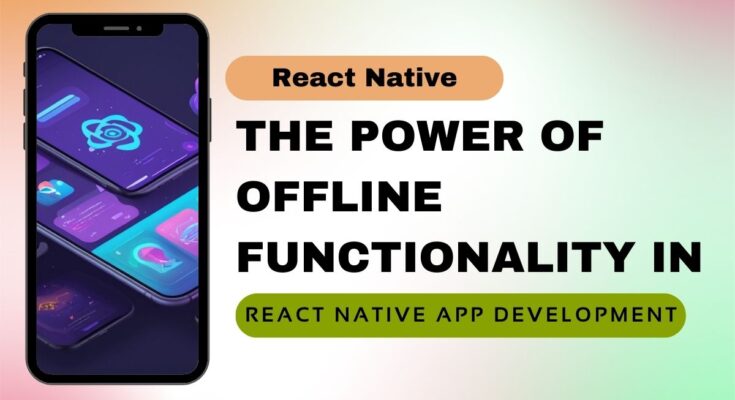Given how quickly everything is happening online these days, mobile applications are crucial. Users want a faultless experience regardless of their internet connection.
React Native, a popular framework for building cross-platform mobile apps, recognizes the need of offline capability. Learn how offline support for React Native app development improves performance, handles network-related problems, and more in-depth analysis of how it impacts the user experience in this article.
Learning about Offline Functionality
You must understand the significance of offline functionality if you want to create trustworthy and intuitive programs for mobile devices. When a mobile app can keep running well even when there is slow or no internet connection, we say that it has offline functionality.
There are a number of ways in which the user experience is enhanced by the focus on offline functionality inside the framework of React Native, which is widely used across cross platform app development platforms.
With React Native’s offline functionality, users can access important functions and information without interruption, no matter where they are or how good their internet connection is. Among the primary advantages is this. This reliability leads to a better and more satisfying user experience.
An important aspect of React Native apps is its offline functionality, which goes beyond just ensuring the program can run even without an internet connection. It improves the application’s overall robustness, performance, and user experience, among other things. Shall we go further into these advantages?
1. Improvements to the User Experience:
Thanks to offline capabilities, crucial functions and information may still be accessible even when the user doesn’t have a network connection. When consumers are in areas with slow or nonexistent internet, this is a lifesaver. The seamless integration of the app’s online and offline modes results in a more reliable and user-friendly experience.
Thanks to offline functionality, users may still engage with the app without interruptions, even when their network connections are inconsistent. Users’ trust and satisfaction are enhanced by this consistency, leading to increased engagement and loyalty.
2. Improved Performance
React Native apps that are offline-friendly and employ local caching technologies may make content load faster. With commonly accessed data stored locally on the device, fewer server requests will be necessary. Because of this, the user interface becomes more responsive and fluid, and performance is enhanced.
Offline capability allows for the local execution of certain operations, which reduces the strain on servers. Applications with a large number of users must undergo this optimization in order to maximize the use of server resources. It also aids in making the infrastructure more scalable and inexpensive.
3. Fixing Network Issues:
Developers may simply include strong error-handling mechanisms using React Native’s offline functionality. If the program notices that the user’s network connection isn’t working, it could provide them some advice on how to fix the issue or explain why it happened. A more pleasant and less frustrating experience for the user is achieved by this clever approach.
Because the software seamlessly transitions between offline and online modes, users may continue with their tasks without interruption. Users can have trust that the app will adapt to the network conditions and provide a consistent experience, regardless of whether they’re in regions with spotty coverage or the subway is down.
4. Strengthened Interaction and Customer Retention:
Having apps that can work without an internet connection means that consumers can still access crucial features. Users are more likely to remain engaged and loyal to the app as a result of this. As an example, whenever and whenever users like, they may jot down ideas using a note-taking application that allows offline editing.
News and entertainment applications, which rely on user engagement to generate revenue, benefit greatly from offline mode, which lets users store articles, movies, and other material for later viewing. Because of its versatility, users remain interested for an extended period of time.
5. Making It Operate in Different Contexts:
The ability to use applications without an internet connection makes them available to more people in more places. Because of how easily it may be used, the software can reach many people, even in countries with slow internet or fewer people overall.
Users that travel often rely on offline applications like translation, trip planners, and maps. Even while going to areas with expensive or inconsistent network connectivity, vital data and React Native app development services will still be available, thanks to this.
Examples in Real Life
In order to enhance user experiences and ensure that their applications run in varied conditions, major corporations have successfully integrated offline capabilities into their React Native apps.
Now let’s dive into some real-life instances of React Native apps that effectively use offline capabilities:
1. Facebook
The offline feature which may be best exemplified using the React Native app for Facebook is one of the ways the user engagement can be increased. Users may view feeds, proceed with previously loaded content, and post-join them altogether independently of the speed or nonappearance of the system.
Loading data by Facebook requires the use of caching technology as well as some intelligent algorithm. Local storage allows the users to shift from the time bound factors to being non-dependent on the timing of internet connection. Contents to be shown are pre-loaded during a stable internet connection when the app determines an error of a stable internet connection.
2. Airbnb
At this point, one can manage his/her holidays with the Airbnb React Native app, even when he or she is offline. Although users are capable of receiving property details, edit bookings and stored itineraries offline, better internet access for the mobile website is desirable.
Airbnb has a local cache mechanism that sees to it that critical data on the trip is stored. This means that the program will continue executing despite unstable or interrupted Internet connectivity thus providing access to important information to the consumer even if there is absent Internet linkage.
3. New York Times Crossword:
In the New York Times Crossword app, with the help of React Native development New Yorkers can download puzzles, and engage in the crossword even while they are not connected to the Internet, whenever or however they are flawed. As for crossword enthusiasts, this update will surely make them happy because now the app can be in better use when one is on a lazy internet.
It is likely that the program uses a caching strategy where the previously completed crossword puzzles as well any information about the crossword puzzles in question, when the user is connected to internet, are saved. From then on, the software, once the user progress is saved, player is allowed to disconnect from the internet and continue puzzle solving while not online.
4. Scratch
Trello, popular software for managing projects, leverages React Native to provide robust offline capabilities. Users may still create, edit, and organize boards even when they don’t have an internet connection, ensuring that their capacity to do so is unaffected by network troubles.
Trello makes use of both caching and synchronization methods. Local caching allows users to view their boards and tasks even without internet connection. Background synchronization ensures that any changes made while offline are reflected on the server upon returning to an online state.
Conclusion
You can’t overstate the importance of React Native apps’ offline functionality. Developers may build robust applications that are accessible in many locations and for diverse users by integrating online and offline experiences.
To accommodate the ever-changing nature of network connections, React Native apps make use of caching mechanisms, service workers, data synchronization techniques, and network detection. As the demand for mobile app development continues to rise, it is becoming more vital to provide a consistent and reliable user experience regardless of network conditions.
Developers can build apps that consumers won’t believe exist since React Native prioritizes offline functionality. To keep up with the dynamic world of mobile applications, boost user engagement, improve speed, and add more fun, developers using React Native may take use of offline functionality.




